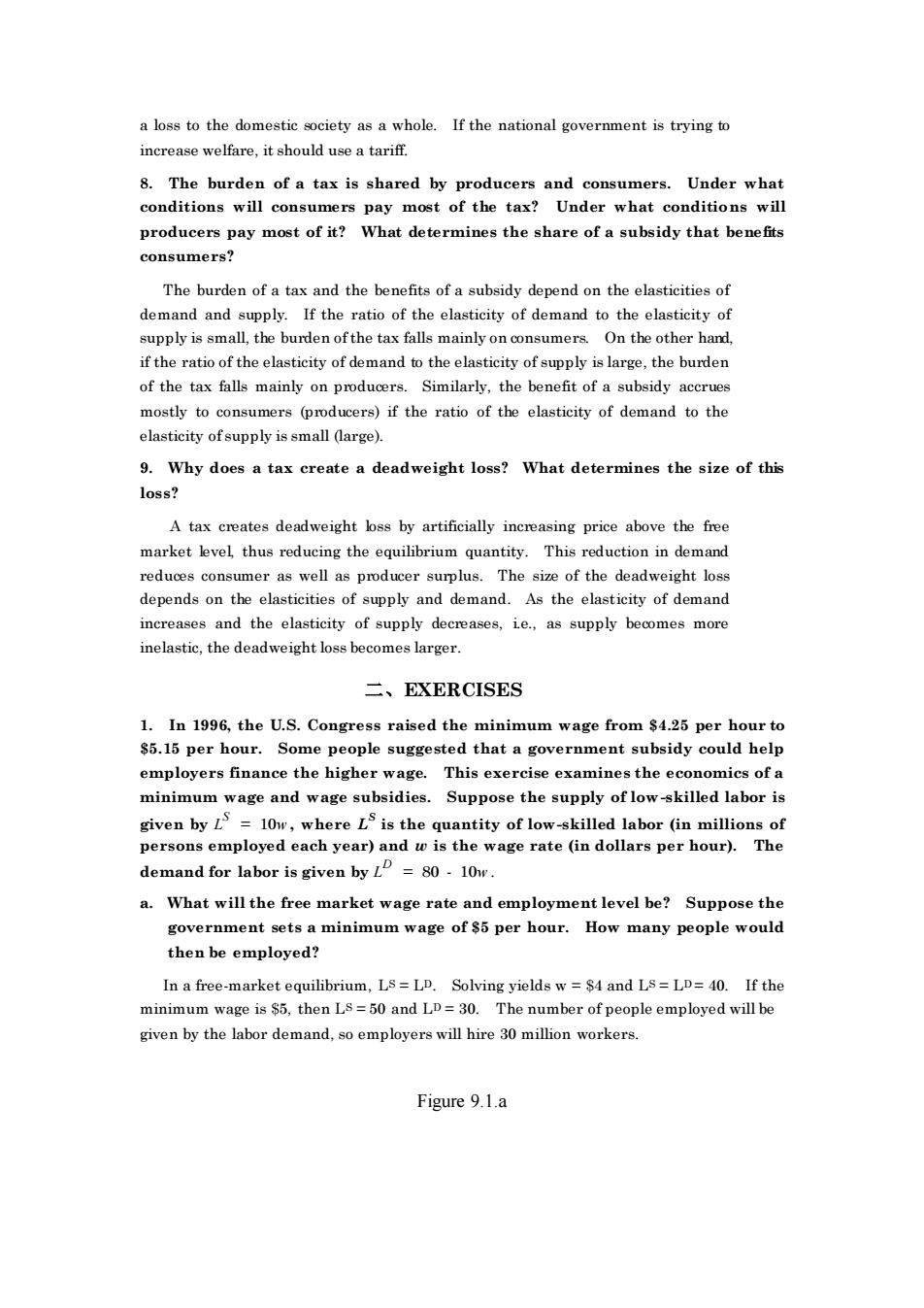正在加载图片...

a loss to the domestic society as a whole.If the national government is trving to increase welfare,it should usea tariff. 8.The burden of a tax is shared by pr oduce mers. Under what producers pay most of it?What determines the share of a subsidy that benefits consumers? The burden of a tax and the benefits of a subsidy depend on the elasticities of demand and supply.If the ratio of the elasticity of demand to the elasticity of supply is small.the burden of the tax falls mainly on onsumers On the other hand. f the ratio of the the burde of the tax falls mainly on producers.Similarly,the benefit of a subsidy accrues mostly to consumers (producers)if the ratio of the elasticity of demand to the elasticity ofsupply is small (large). 9.Why does a tax create a deadweight loss?What determines the size of this loss? A tax reates deadweight ss by artificially increasing price above thefree market evel thus reducing quantity.This reduction in dema reduces consumer as well as producer surplus.The size of the deadweight loss depends on the elasticities of supply and demand.As the elasticity of demand increases and the elasticity of supply decreases,ie.,as supply becomes more inelastic,the deadweight loss becomes larger. 二、EXERCISES 1.In 1996,the U.S.Congress raised the minimum wage from $4.25 per hour to 5.15 per hou Some p ole sug gested that a governm ent subsidy ould help This exercise examine omics of minimum wage and wage subsidies.Suppose the supply of low-skilled labor is given by LS 10w,where LS is the quantity of low-skilled labor (in millions of persons employed each year)and w is the wage rate(in dollars per hour).The demand for labor is given by L=80-10w a.What will the free market wage rate and employment level be?Suppose the government sets minimum wage of$5 per hour.How many people would then be employed? In a free-market equilibrium,L8=LD.Solving yields w=$4 and Ls=LD=40.If the minimum wage is $5.then Ls=50 and LD=30.The number of people employed will be given by the labor demand,so employers will hire 30 million workers. Figure 9.La a loss to the domestic society as a whole. If the national government is trying to increase welfare, it should use a tariff. 8. The burden of a tax is shared by producers and consumers. Under what conditions will consumers pay most of the tax? Under what conditions will producers pay most of it? What determines the share of a subsidy that benefits consumers? The burden of a tax and the benefits of a subsidy depend on the elasticities of demand and supply. If the ratio of the elasticity of demand to the elasticity of supply is small, the burden of the tax falls mainly on consumers. On the other hand, if the ratio of the elasticity of demand to the elasticity of supply is large, the burden of the tax falls mainly on producers. Similarly, the benefit of a subsidy accrues mostly to consumers (producers) if the ratio of the elasticity of demand to the elasticity of supply is small (large). 9. Why does a tax create a deadweight loss? What determines the size of this loss? A tax creates deadweight loss by artificially increasing price above the free market level, thus reducing the equilibrium quantity. This reduction in demand reduces consumer as well as producer surplus. The size of the deadweight loss depends on the elasticities of supply and demand. As the elasticity of demand increases and the elasticity of supply decreases, i.e., as supply becomes more inelastic, the deadweight loss becomes larger. 二、EXERCISES 1. In 1996, the U.S. Congress raised the minimum wage from $4.25 per hour to $5.15 per hour. Some people suggested that a government subsidy could help employers finance the higher wage. This exercise examines the economics of a minimum wage and wage subsidies. Suppose the supply of low-skilled labor is given by L w S = 10 , where L S is the quantity of low-skilled labor (in millions of persons employed each year) and w is the wage rate (in dollars per hour). The demand for labor is given by L w D = 80 - 10 . a. What will the free market wage rate and employment level be? Suppose the government sets a minimum wage of $5 per hour. How many people would then be employed? In a free-market equilibrium, LS = LD. Solving yields w = $4 and LS = LD = 40. If the minimum wage is $5, then LS = 50 and LD = 30. The number of people employed will be given by the labor demand, so employers will hire 30 million workers. Figure 9.1.a